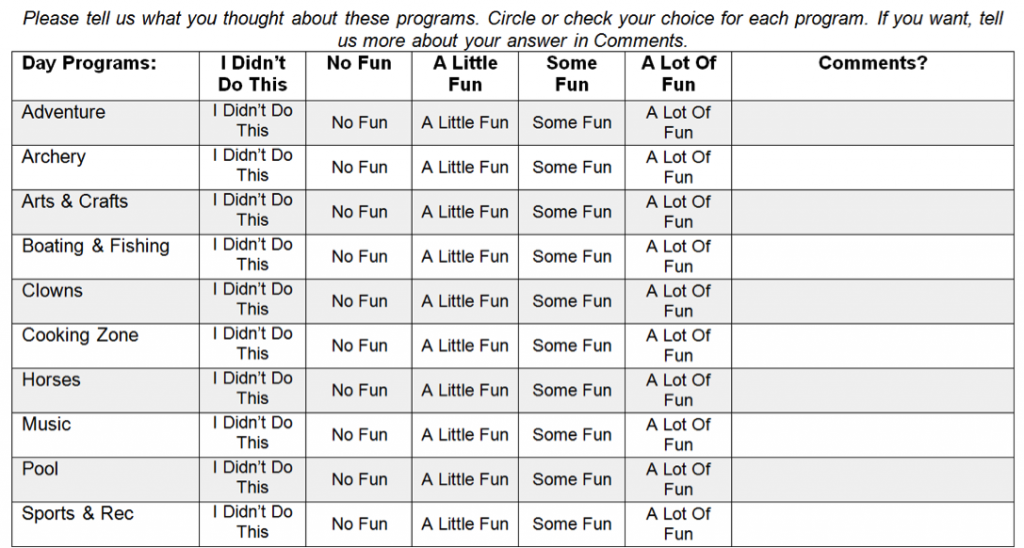Howdy! I’m Ann Gillard, Ph.D., Director of Research and Evaluation at The Hole in the Wall Gang Camp, located in Ashford, CT. The Hole in the Wall Gang Camp was founded by Paul Newman in 1988 and serves children and families in our region who are living with serious and life-threatening illnesses through summer camp, family weekends, hospital outreach, alumni, and other innovative programs. In my role, I frequently create surveys for children to find out about their levels of satisfaction with the program activities.
Lessons Learned:
- “Levels of satisfaction with the program activities” is not too child-friendly! Instead, I created a “Fun Scale” (H/T to Mark F. Roark, Utah State University).
- The response categories in the Fun Scale are: I Didn’t Do This, No Fun, A Little Fun, Some Fun, and A Lot of Fun. Here is a snippet of the survey:
- In my other qualitative research with youth in camp settings, the idea of “fun” really varied by child. For example, a common answer to the interview question “What did you like about camp?” was “It was fun!” Probing questions would typically reveal why it was fun – doing new or challenging activities, being with friends, feeling a part of a group, etc. It would be easy to overthink this, but I wanted the survey to be simple and manageable.
- For this survey, it was less important to understand what made each activity fun, and more important to provide campers with a quick opportunity to self-report fun.
- Campers aged 7-18 completed this on their second-to-last-day at camp, and reliability for the scale was very good, even for the younger campers.
- Follow-up observational tools and interviews with staff revealed some key aspects of the most fun activities, such as freedom to make choices, skill-building, and doing an activity at camp that they couldn’t do at home.
Hot Tips:
- Include an option for “I didn’t do this.” In reviewing the data from the first camp session, we found that some campers said an activity was A Lot of Fun, even though their group didn’t actually go to that activity!
- Include a “Comments” option. Only a few campers entered comments, but counselors reported that those campers enjoyed making jokes or indicating their favorite activity.
- Consider how results will be utilized. In our case, looking at the key components of the most fun activities helped guide discussions with program staff in a program improvement process.
- Fun scores can be analyzed to see how they relate to outcomes (such as feelings of safety or friendship), and how fun might differ by group (i.e., girls and boys, older and younger campers, etc.).
- Remember that it’s OK for children to have fun at camp!
Do you have questions, concerns, kudos, or content to extend this aea365 contribution? Please add them in the comments section for this post on the aea365 webpage so that we may enrich our community of practice. Would you like to submit an aea365 Tip? Please send a note of interest to aea365@eval.org . aea365 is sponsored by the American Evaluation Association and provides a Tip-a-Day by and for evaluators.


I love this! Thanks so much for sharing. It’s simple, straightforward, and meaningful for kids.
Thanks, Cathy!